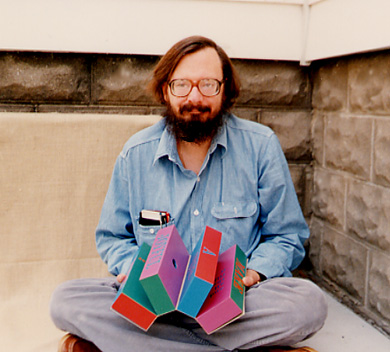


L-R: Morgan Gibson, Karl Young & Karl Gartung
In 1967, nine years before I was to first meet Lyn Hejinian face-to-face at a book fair at
I didn’t actually meet Gibson until after he’d accepted my work for publication, but I’d known about him for a few years. He was something of the official radical-on-campus at the
As a Rexroth scholar, Gibson came by his radicalism organically. Since leaving UWM, Gibson has spent much of his time in
I lost all
friends but you.
Now you.
*
Watching snow
listening to snow
and “snow.”
*
Sounding
shaping
darkness.
The above are excerpts from “In Mummy-Bag,” a sequence that can be found in the latest issue of Gam, Stacy Szymaszek’s mag from Milwaukee, the third issue of which focuses on what the cover describes as “(some) roots of experimental writing in Milwaukee.” This is a terrific idea for a special issue of a mag, especially one coming from (and thus documenting) any other place than
Young is undoubtedly the most widely known of the three. Karl was one of the very first poets to understand the potential of computers and the internet as a mechanism for enabling the creation, distribution and archiving of poetry. His Light & Dust Anthology of Poetry is the grand-daddy of web poetry archives & remains a great resource. It was Karl who originally invited me to edit a special issue of Margin on the poetry of Clark Coolidge, which more than anything made me conscious of the value of being able to talk & write critically about new modes of poetry. Karl’s own poetry is diverse in mode & impulse. And while he might be more famous today if he were to hone in on a single mode poem around which to build a brand (I’m actually being serious when I say that), what’s really kept him from becoming the household name he deserves to be has been that he’s reserved his great energies to promote poetry, rather than to advocate for Karl Young’s poetry. That’s a generosity of spirit that should never be discounted.
If Karl Young is the most widely known of the three, Karl Gartung is probably the least. He seems to share that allergy toward self-promotion with both Young & Gibson. If Gartung has ever published a book, I’ve not had the fortune to see it – indeed, I’ve seen relatively few works in mags over the years. I did a search on Google & the first piece of actual writing I found was an article in Teamsters for a Democratic Union – Gartung has been a fulltime truck driver as long as I’ve known him, which has enabled him & his longtime partner Anne Kingsbury to create & build Woodland Pattern, hands down the best poetry bookstore in the entire nation.
So I was especially happy to see some of Gartung’s work in the issue, poems that reflect a relaxed post-projectivist impulse. I’m not sure just how well I’ll be able to get Blogger to handle the spacing of this one properly, but here’s my favorite:
If
or
if not
true
We cannot
at this point
know them
though we would
much less prevent
what happened
much as we
will not prevent
such things
happening
again though we
would
and will become
mere vapor
in the heat
that sheer knowledge
that fog that
will remain
impenetrable
so we must
act
on our local
curiosities
constructing
such truth
as may be constructed
at close range
“Constructed / at close range” indeed! It’s an amazing thing that nobody’s thought to do such an issue as this before. The idea of promoting a sense of history about your place, wherever that might be, makes such great sense. It’s worth noting of course that none of the three took exactly the same route to the post-avant, nor were they the only people in & around
Gam is published in an issue of 100, so if you want this one – and it’s definitely a keeper – I suggest writing to Stacy Szymaszek at stacyszymaszek@sbcglobal.net sooner rather than later.





